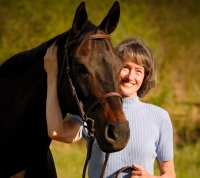TRUE TRAINING 72 - Belly Deep in Snow
Horses’ brains need some variety in their activities. Because of that, I bring trail horses in for arena work at times, send jumpers out to explore the neighborhood, and teach True to handle all sorts of things that his breeding and discipline don’t require. Last week, we went for a ride in the snow.
True and I explore snow-plowed driveways every winter, either mounted or on a lead. We have lots of fun doing that; he looks all around at the environment, checks out the other horses, gets a nice long fluid walk that stretches his hips and shoulders, and learns to handle unusual events. But until last week, I had never ridden him through deep snow.
Deep snow is hard work for a horse, so I kept the hills to two 10-minute stretches on this first attempt. We added deep snow on the flat for a total ride of about 30 minutes. We went with a horse-and-rider team who True knows well, so he would feel more comfortable. His equine companion has been ridden in deep snow often, is calm on trails, and knows the ropes, so to speak. We walked on the plowed driveways for 15 minutes first, then I asked him to step through a berm of plowed snow to get into the virgin stuff.
It was 2 ½ to 3 feet deep beyond the berm, but the berm itself was higher than that. True sunk to his elbows on the first step and stopped. It was a nice stop—a check-in, as if to ask “Hmm, are you sure about this?” My legs gently said yes, so Trooper proceeded through the berm.
My friend and I selected a location we knew well from summer and fall riding—a place with no holes. Holes are my biggest worry in deep snow. You can’t see them, and a hoof or leg down a hole promises injury. True’s jumper legs can’t afford any injuries. They’re still smooth and tight, and I aim to keep them that way. It's also a good idea to check for ice beneath the snow and to be sure your horse has good hoof traction. We traversed a path that we knew contained no holes or ice, and we remained at a walk.
We also don’t do roads, unless the shoulders are wide enough to keep us 40 or 50 feet away from cars. The roads near the ranch are rarely used, but it only takes one speeding vehicle to slide on gravel or snow and scare or hit a horse. That’s not a chance I’m willing to risk. We have plenty of square miles to ride that don't contain roads or cars.
Well, over the berm and off we went. There’s no better way to feel the strength of a horse than to ride him up a steep hill in deep snow. True paused with questions once or twice, but immediately continued up, up, and up when I asked. His friend remained a little ahead of him the first time up, though we were on separate tracks so that both horses would get the full effect of snow exercise. True led the way on the second climb. Hill work in any season is great exercise for building hindquarters, and snow amps up the results.
It was a simple day, with a bright sun in a deep blue sky, making our high plateau full of snow sparkle like sugar. I felt proud of my horse for his power and strength, but equally for his mental willingness and cooperative nature. My friend and I chatted; True’s friend and he followed each other quietly. The only time True became excited is when we saw four or five loose horses galloping in a big neighboring field. He was ready to gallop too, in solidarity.
Next time you’re complaining about winter—the indoor is dusty, the weather is cold, the horses are cooped up, the jumps are buried and the trails are covered—look around and see if there is an outdoor ride near you that might be a fun excursion for both you and your horse. Even an arena in deep snow can be pleasant.

